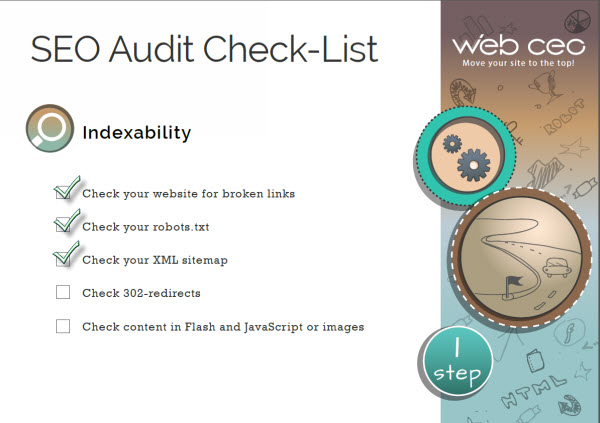
This blog post is written for you, if you promised yourself to do more SEO on your website, but don’t know where to start.
First of all, prepare the list of your most important web pages’ URLs and the keywords they are optimized for (remember that 1-3 keywords per page is optimal).
Check your site’s quality and essential optimization.
The first stage in doing a site audit consists of two parameters: checking for indexability and good on-the-page optimization. These two parameters influence the site quality that search engines pay attention to while ranking your pages.
Search engine bots can scan your website’s page if:
- there is a link from another page pointing to it;
- it is mentioned in your XML sitemap;
- robots.txt allows the page to be indexed;
- there are no SEO-unfriendly redirects.
This means that you will need a broken links report, information about pages and bots that are blocked by your robots.txt. You will also want to check whether your redirects are SEO-friendly if you have any (they should be 301 redirects) and to examine your XML sitemap.
Your next step is to make sure that the pages search engine bots index are well-optimized. Here you will need to check:
- Your Title tags: do they exceed the optimal length? Are there pages with duplicate Titles?
- Your Description tags: as with the Title tags, you will need to check their length and for the presence of duplicates.
- Your H1 headings: there should be only one H1 heading on the page and they should be unique across the site.
- Number of outgoing links: if you have more than 50 on a single page, search engines may consider it’s a link farm and penalize you.
- Your keywords: make sure you have keywords in the URLs, Title and Description tags, H1 headings and body of the page. But remember that text should sound natural and not look like spam.
We recommend that you use the WebCEO Online Site Auditor tool for this SEO audit stage, it provides you with all the information mentioned above.
Check your backlink quality and quantity.
SEO trends change as often as fashion does. Recently more backlinks meant better ranks, but today it’s not exactly so. Google has even created a special tool to disavow “bad” links.
Why would you want to disavow links? Because last summer Google started to pay attention to “unnatural link activity” and alert webmasters when their activity was seen as spam-like. If your competitors do not shun any methods to outrank you and place links to your pages on really spammy sites, you can always disavow them. We do not recommend that you abuse this tool, but it’s always good to know that you can avoid being seen in bad neighborhoods this way.
Let’s get back to the SEO audit. You will need to check the quantity of your backlinks and check their quality. You can also check your competitors’ backlinks, in order to get ideas about what neighborhoods you can get more involved in.
Check your rankings in comparison with your competitors.
It may be odd to remind you about this, however remember that your task is to get ranking positions higher than your competitors have. This will give you more clicks, hence more sales and more money. A good practice is to schedule an automatic rank check once a month and after any big SEO changes you’ve implemented. We advise that you try the automatic ranking reports created by the WebCEO Online Rank Checker.
Check your content
We all know – content is king. Check whether you treat your site’s content accordingly.
Read the text of your important pages as a visitor will do. Assure that the content is clear and readable, with correct spelling and no grammar mistakes.
Now have a look at the content as if you are a search engine bot. Is your content trapped inside Flash, overly complex JavaScript or images? Are there keywords in the first paragraph? Are there too many keywords stuffing the page?
Read the content from an SEO point of view. Does your site suffer from keyword cannibalism? Keyword cannibalism describes the situation where your site has multiple pages that target the same keyword. Create a keyword index that maps keywords to pages on your site to check whether there are cannibalized keywords. If you notice this, merge the pages that are aimed to the same keywords or retarget one of them.
The last eyes you need to use are the eyes of an ambitious copywriter. Check whether your pages have duplicate content and rewrite them if they have. Then use Copyscape to make sure other sites do not steal your content.
Download and print the SEO Audit check-list and begin fixing the problems in order to get better results now.



